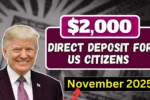Amid discussions on social media and newsfeeds, many Americans are asking whether $2,000 federal direct deposit payments will arrive in October 2025. The idea sounds promising—especially amid rising living costs—but the reality is a bit more complicated. Here’s everything you need to know, written in a straightforward and reader-friendly style.
What’s Happening?
Recently, posts and websites have claimed that a new federal payment of approximately $2,000 will arrive in bank accounts in October 2025. One article stated that many Americans may receive “deposits around this amount” from existing programs.However, the official statement from the Internal Revenue Service (IRS) and other federal agencies is clear: no new nationwide stimulus checks of $2,000 have been officially announced.
Why Are People Talking About a $2,000 Payment?
The talk of a $2,000 federal direct deposit began after policy discussions in Washington focused on:
-
Rising inflation and affordability issues
-
High living costs for seniors and low-income households
-
The need for economic support in selected sectors
-
Possible adjustments to Social Security
-
Ongoing debate about federal financial relief in election year 2025
These discussions have led many news outlets and online platforms to claim that a new $2,000 stimulus-like payment may be issued in October 2025 — but as of now, nothing has been announced as a universal federal program.
Instead, the payment is expected to be part of targeted assistance, not a blanket payout for all Americans.
What the Expected Payment Could Be
Several programs currently under review could result in direct deposits of up to $2,000, including:
1. Supplemental Payments for Seniors
Congress has been reviewing proposals aimed at:
-
Retirees
-
Social Security beneficiaries
-
Those receiving SSI or SSDI
These proposals suggest a one-time adjustment or “relief bonus” to help seniors cope with rising prices.
2. Cost-of-Living Adjustment (COLA) Enhancements
If inflation spikes again before fall 2025, the COLA increase could reach higher-than-expected levels for Social Security recipients, resulting in a payout around the $2,000 mark.
3. Federal Anti-Inflation Relief Payments
Some lawmakers have pushed for a nationwide anti-inflation relief plan, similar to stimulus checks, but more targeted toward lower-income families.
4. State-Level Bonus Payments
Certain states are considering:
-
Inflation checks
-
Tax rebates
-
Energy credits
-
Housing-support payouts
Some of these may total up to $2,000, contributing to the growing belief that a major federal payment is coming.
Expected Distribution Timeline
If approved, the October 2025 payment would likely be distributed in the following order:
1. Direct Deposit
Beneficiaries receiving:
-
IRS refunds
-
Social Security payments
-
SSI / SSDI deposits
would likely be the first to receive the funds via automatic direct deposit.
2. Paper Checks
For those without bank accounts, mailed checks may take 3–6 weeks longer.
3. Debit Cards
Some programs may use EIP debit cards, as done in previous stimulus rounds.
Who Is Expected to Qualify?
If the $2,000 payment becomes official, eligibility will likely include:
1. Seniors and Retirees
Including:
-
Social Security Retirement
-
SSI (Supplemental Security Income)
-
SSDI (Social Security Disability Insurance)
2. Low-Income Workers and Families
Households below a certain income threshold may qualify for full or partial payments.
3. Veterans
VA disability recipients may receive the payment automatically.
4. Taxpayers Who Filed Their 2024 or 2025 Returns
Eligibility may depend on tax filing status.
5. Americans Impacted by High Living Costs
Some proposals target:
-
Rent-burdened households
-
Caregivers
-
Those with dependents
-
Single parents
-
Disabled individuals
Important Reality Check
There is no officially confirmed nationwide federal stimulus of $2,000 as of now.
However:
-
Discussions are active
-
Proposals are pending
-
October 2025 is being considered as a target month
-
Certain groups may receive relief payments up to $2,000
This means Americans should stay alert for official updates from the IRS or Social Security Administration, not rely solely on online rumors.
Benefits If the Payment Is Approved
-
Helps households manage inflation
-
Supports seniors with limited fixed income
-
Reduces economic pressure on low-income families
-
Stimulates local economies
-
Protects vulnerable groups from rising costs
Potential Challenges
-
Congressional approval is required
-
Not all Americans would qualify
-
Payment amounts may vary
-
Timing could shift from October
-
Political debates may delay or reduce payouts
FAQs
1. Is the $2,000 federal direct deposit confirmed?
No. It is widely discussed and proposed, but not officially approved.
2. Who would qualify if it becomes official?
Most likely:
-
Seniors (Social Security, SSI, SSDI)
-
Low-income families
-
Veterans
-
Households under an income cap
3. When would the payment arrive?
If approved, most estimates point to October 2025, with direct deposits arriving first.
4. Will every American receive $2,000?
No. This is expected to be a targeted payment, not universal.
5. Will the IRS distribute the payment?
Yes — if it becomes a federal program, the IRS and SSA would handle distribution.
6. Do I need to apply?
Likely no for seniors, disabled individuals, and taxpayers who already filed returns.
Low-income individuals without tax filings may need to submit a non-filer update, depending on rules.
7. Is this the same as a stimulus check?
It is similar but expected to be more targeted, not a universal relief check like the 2020–21 stimulus rounds.
8. What should I do now?
-
File your taxes on time
-
Keep your direct deposit info updated
-
Watch for official announcements





